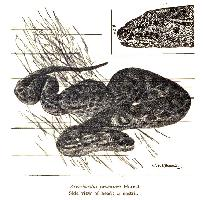
Súlyok és méretek
| Hossz | 250 cm |
|---|---|
| Súly | 10 kg |
Állatleírás
The Elephant Trunk Snake, scientifically named Acrochordus javanicus, is a distinctive and fascinating aquatic reptile native to Southeast Asia, including parts of Indonesia, Malaysia, Thailand, Vietnam, and the surrounding waters. This species belongs to the family Acrochordidae, which is known for its unique, loose, and baggy skin that gives these snakes a decidedly wrinkled appearance, reminiscent of an elephant's trunk, hence their common name.Adult Elephant Trunk Snakes can reach lengths of up to 2.5 meters (8.2 feet), although most specimens are generally smaller. Their bodies are robust and muscular, adapted for an aquatic lifestyle. The skin of these snakes is not only loose and wrinkled but also covered in small, rough scales that aid in gripping slippery prey such as fish, their primary diet. This skin texture, combined with a muted palette of browns, grays, and sometimes olive greens, allows the Elephant Trunk Snake to blend seamlessly into the murky waters of its habitat.
One of the most remarkable features of the Elephant Trunk Snake is its lack of ventral scales, which are typical in many other snake species and aid in terrestrial locomotion. This anatomical adaptation underscores the snake's fully aquatic nature, as it rarely, if ever, ventures onto land. Instead, these snakes are powerful swimmers, using a combination of lateral undulation and concertina motion to move through the water with surprising agility, stalking their prey with stealth and precision.
The diet of the Elephant Trunk Snake primarily consists of fish and occasionally amphibians. They are nocturnal hunters, relying on the cover of darkness to ambush unsuspecting prey. Their method of capturing food is unique; they use their body to constrict and immobilize their catch, despite not being true constrictors in the sense of other snake species. Their loose, baggy skin plays a crucial role during feeding, as it allows them to swallow large, slippery prey with ease.
Reproduction in Elephant Trunk Snakes is ovoviviparous, meaning they give birth to live young rather than laying eggs. Females can give birth to a significant number of offspring, ranging from a few dozen to over a hundred in some cases, ensuring the continuation of their species despite their relatively low profile in the wild.
The Elephant Trunk Snake's habitat typically includes slow-moving rivers, lakes, and estuaries, where the water is calm, and vegetation is abundant. These environments provide not only the cover they require for hunting but also the warm temperatures essential for their cold-blooded metabolism.
Despite their fascinating nature and ecological importance, Elephant Trunk Snakes face threats from habitat destruction, pollution, and the exotic pet trade. While they are not currently listed as endangered, their populations are under pressure in several regions. Conservation efforts and responsible pet ownership are crucial to ensuring that these unique reptiles continue to thrive in their natural habitats for generations to come.
Új állatfotók
Top 10 állat
- Diana monkey (Cercopithecus diana)
- Dolphin gull (Leucophaeus scoresbii)
- Moustached guenon (Cercopithecus cephus)
- Galápagos tortoise (Geochelone nigra complex)
- Stone loach (Barbatula barbatula)
- Japanese spider crab (Macrocheira kaempferi)
- Colossal squid (Mesonychoteuthis hamiltoni)
- Common house mosquito (Culex pipiens)
- Common reed warbler (Acrocephalus scirpaceus)
- Sea urchins (Echinoidea)